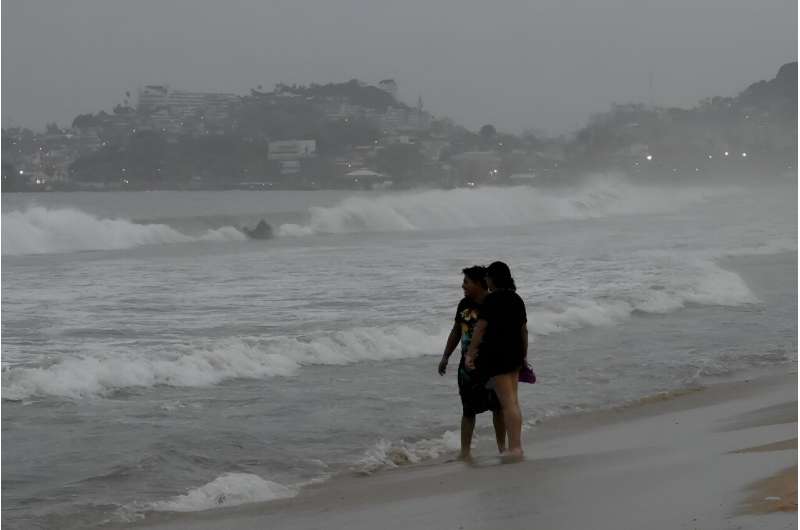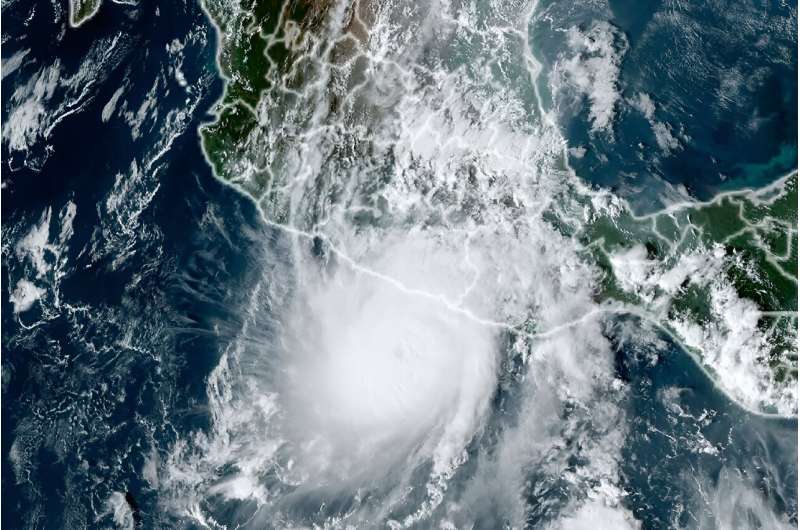This article has been reviewed according to Science X's editorial process and policies. Editors have highlighted the following attributes while ensuring the content's credibility:
fact-checked
reputable news agency
proofread
'Potentially catastrophic' Hurricane Otis hits Mexico

A major Category 5 hurricane made landfall near Mexico's Pacific beach resort of Acapulco early Wednesday, threatening to wreak "catastrophic" damage, the US National Hurricane Center (NHC) said.
Hurricane Otis was packing maximum sustained winds of 165 miles (265 kilometers) per hour when it came ashore, the NHC said.
The storm had rapidly strengthened to the most powerful category of the five-step Saffir-Simpson scale as it neared land.
"Catastrophic damage likely where the core of the hurricane moves onshore," the NHC warned.
President Andres Manuel Lopez Obrador made an appeal on social media for people to move to emergency shelters and away from rivers, streams and ravines.
Earlier, soldiers were seen patrolling the beach of Acapulco, where visitors had made the most of the calm before the storm.
"We won't be running any tours today," boat operator Carolina Torres said, voicing hope that Otis might weaken before making landfall.
"If it hits us, that's very serious for us," she added.
Rainfall of up to 20 inches (51 centimeters) was expected across Guerrero and parts of neighboring Oaxaca state, the NHC said.
"This rainfall will produce flash and urban flooding, along with mudslides in areas of higher terrain," it warned.

"A potentially catastrophic storm surge is expected to produce life-threatening coastal flooding," it added.
Hurricanes hit Mexico every year on both its Pacific and Atlantic coasts, usually between May and November, though few make landfall as a Category 5.
In October 1997, Hurricane Pauline hit Mexico's Pacific coast as a Category 4 storm, leaving more than 200 people dead, some of them in Acapulco.
It was one of the deadliest hurricanes to batter Mexico.
In October 2015, Patricia became the most powerful hurricane ever recorded, pummeling Mexico's Pacific coast with sustained winds of 200 miles per hour.
But the storm caused only material damage and no deaths as it made landfall in a sparsely populated mountainous area.
Just this week, Tropical Storm Norma left three people dead, including a child, after making landfall for a second time in the northwestern state of Sinaloa.
Norma came ashore for the first time on the Baja California peninsula on Saturday before heading back out to sea, later barreling into the mainland.
Earlier this month, two people died when Hurricane Lidia, an "extremely dangerous" Category 4 storm, struck the western states of Jalisco and Nayarit.
And in August, storm Hilary, which at one point was also a Category 4 hurricane, caused one death and damaged infrastructure when it hit Baja California.
Scientists have warned that storms are becoming more powerful as the world gets warmer with climate change.
© 2023 AFP

















